“Stay at home. Protect the NHS. Save lives.” The catch cry of pandemic Britain under Boris Johnson, revived last month, might sound familiar to New Zealanders now enjoying their “unstoppable summer”.
Johnson’s three-part slogan reportedly derived last March from a suggestion by Ben Guerin, a 25-year-old Kiwi who advised on the Conservatives’ social media strategy. His attention had been caught by a phrase that was increasingly prevalent in Prime Minister Jacinda Ardern’s messaging back home: “Stay at home, save lives.”
But there, the two countries’ strategies to fight Covid diverged. Now, one year on from recording its first case of coronavirus, New Zealand has largely eradicated community transmission. England remains in lockdown, having revived its “stay home” slogan last month ahead of its third and toughest restrictions. The two countries’ death tolls stand at 26, and more than 100,000 respectively.
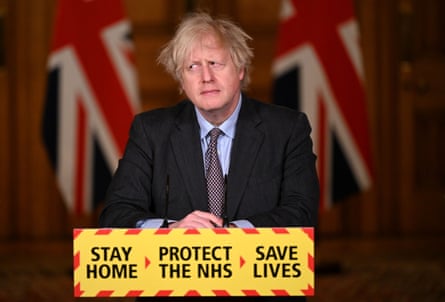
Some have resisted global comparisons with New Zealand’s pandemic success, saying it could not have been replicated in a country with higher population density or land borders. Certainly, New Zealand has had some advantages, but one cornerstone of its Covid response was not at all specific to its geography: its communication strategy.
Information design may seem a superficial front by which to assess a pandemic response; but whatever course a government chooses to take against the virus – whether it be elimination, control or herd immunity – it is effective only insofar as people understand it.
In New Zealand’s case, the fight against Covid-19 was in large part a communications campaign – and there its success was highly replicable.
“We knew right from the start that our way through this was getting people to do the right thing,” says John Walsh, the senior public servant who led that arm of the government’s response. “One way you do that is you communicate well.”
‘We wanted something very human’
In mid-March, as the number of infections was escalating rapidly, New Zealand opted to pursue elimination – “to go hard, and go early,” as Ardern put it. But the success of a national lockdown depended on the participation of the entire country, which was by no means guaranteed.
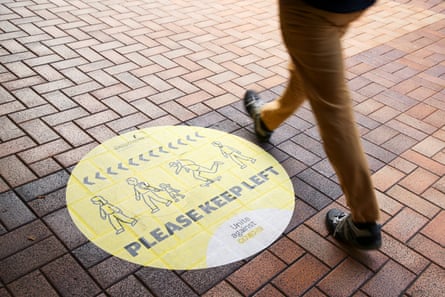
New Zealanders value their freedom and can be “quite individualistic,” says Walsh. As director of readiness and response services at Biosecurity New Zealand, protecting the nation from invasive pests, he had been seconded to lead the crucial work of communicating the strategy to the public.
With a budget of NZ $25m (£13m), he tasked the advertising agency Clemenger BBDO Wellington with coming up with a public information campaign to reach every New Zealander.
Clemenger had a track record of spurring social change; its irreverent ads for the national transport agency, discouraging drink-driving, had become part of the national vernacular. What made the Covid-19 campaign different was the speed of delivery – within a week of the first briefing, on 12 March – and the uncertain parameters.
The brand had to be authoritative but flexible, as effective on billboards as social media and able to convey news of minor disruption or, potentially, deaths. “We had very little visibility of where this was going to go,” says Linda Major, Clemenger’s director of social marketing – but “we did understand that it was going to have to stretch.”
The first major creative decision was not to centre on the virus itself. That January, a visualisation of the virus particle by the US Centers for Disease Control and Prevention (CDC) was ubiquitous. An illustrator said their aim was to help people picture the threat while out in public, in colours chosen to create a “feeling of alarm”.
The New Zealand government’s team opted to take a different route, focusing on the impact on people’s daily lives and steps they could take to protect each other. “We wanted something that was very human,” says Major. Within 48 hours of being briefed, Clemenger had landed upon the organising principle of their campaign: “Unite Against Covid-19”.
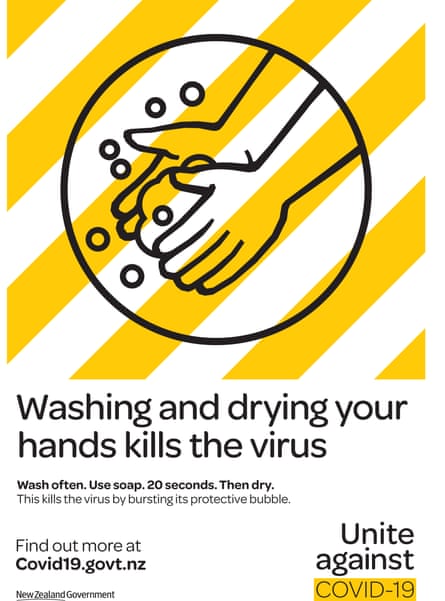
This was to be set up as a standalone brand, to serve as the singular platform for all official communiques through the pandemic. Cheryl Barnes, deputy chief executive of the permanent Covid-19 Group later established to lead the all-of-government response, says the mobility and small size of New Zealand’s public service made that coordination easier: “You knew who to get on the phone.”
From 18 March, advertisements pointing to the Unite Against Covid-19 website – the government’s “single source of truth” for information on the pandemic – flooded radio, television and digital media. In its first three months, the website received 700m views.
But the Unite brand was designed not just as a “top-down directive from government but a call to participate,” says Major.
The aim was to trigger team spirit, not fear; to bring New Zealanders together, and galvanise them to act. “Partly what we were trying to do was give people a common thing to rally or fight against,” says Mark Dalton, Clemenger’s creative director.
That extended to team colours: the now-iconic yellow and white stripes, which were quickly adopted as a unifying symbol of the national response. The shade was chosen for being attention-grabbing without stoking alarm – likewise, the alert tone sounded before each official broadcast. “We didn’t want to raise the national temperature,” says Major.
Despite the stakes, the messaging was overwhelmingly positive in tone, giving “dos” rather than “don’ts” as well as reasons why. Instead of “wash your hands”, for instance, the advice was “washing and drying your hands kills the virus” – to underscore individual agency, and encourage participation in the national response.
Public health directives, such as to cough into your elbow, were illustrated with simple black-and-white pictograms, chosen for their inclusivity. Even illustrations could detract from the central message – as the UK government found recently, withdrawing a poster that sparked complaints of sexism.
In seeking to foster calm and compassion, New Zealand’s messaging was starkly different to that elsewhere. The state of Oregon, for example, ran a campaign with the slogans “Don’t accidentally kill someone” and “It’s up to you how many people live or die”. In the UK, government campaigns have warned “don’t let a coffee cost a life” and shown the reproachful faces of people on ventilators: “Look him in the eyes and tell him the risk isn’t real.”
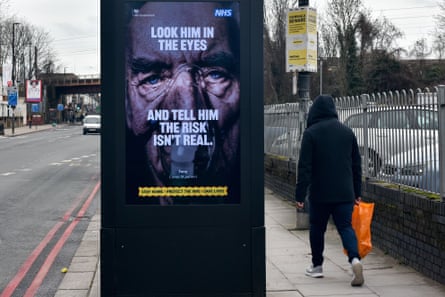
‘We tried very hard not to tell people off’
Paul Gilbert, a clinical psychologist and the founder of the Compassionate Mind Foundation, says there is no evidence to show that triggering negative emotions is an effective influence on behaviour. “People don’t like to be made to feel guilty and they will after a while turn off from it … It’s just very basic psychology.”
What New Zealanders were being asked to do was relatively straightforward, says Walsh: “What was really important was the style, tone, and manner … We worked hard on empathy. We tried very hard not to tell people off, and to be supportive.”
Ardern and the director-general of health, Dr Ashley Bloomfield, led by example, repeating key messages such as “Stay home, save lives”, “Be kind” and “Act like you have the virus.”
The Unite presences on Facebook and Instagram acted as customer service channels; since March, government staff have responded directly to more than 40,000 comments. “It was very much a loop … you’d get insight into what the public was saying, and you’d feed that back into the information that was presented,” says Heather Peacocke, head of public engagement and communications of the Covid-19 Group now leading the government’s response.
This created the sense of a cohesive and ubiquitous response that many New Zealanders felt part of. Businesses, schools and community groups used the Unite branding on their own pandemic advice, while the Clemenger team saw the yellow-and-white stripes applied playfully to birthday cakes, wine bottles and (after lockdown) event invitations. “It felt like ‘Unite Against Covid-19’ was an idea that New Zealanders owned … it didn’t feel quite so government,” says Major.
But the initial response was criticised for insufficient engagement and coordination with Māori and Pacific communities – a particular concern given their increased vulnerability to Covid-19. Shortly after the launch of the Unite campaign, Māori health professionals formed the national Te Rōpu Whakakaupapa Uruta group to push for an equity lens to the response and a specific plan for Māori.
This was only released by the ministry of health, a month into lockdown. Peacocke says the equity and outreach of the government’s response improved over time: “We know we needed to do more to work with iwi Māori to put that te ao lens onto the Covid response, to be able to speak in a way which is more relevant – likewise Pasifica communities.”
What helped in expanding the response was structure, says Peacocke: alongside empathy, the other pillar of the campaign. The alert-level system, requested by Ardern, had helped to impose order amid uncertainty. The framework was similar to the one used within New Zealand for monitoring volcanic eruptions, tying public health measures to four progressive levels of risk.
Though some actions within them had to be clarified, the simplicity of the ladder structure prepared the public for the possibility of more stringent restrictions, and indicated – more so than going “in” and “out” of lockdown – that the recovery may not be linear. “It gave the country a really clear idea of what we were in for, how serious this thing is, and that it was likely to get worse,” says Walsh. “It was a crystal-clear roadmap – people just got it.”
The communications strategy through lockdown was informed by experts such as Dr Sarb Johal, a clinical psychologist specialising in psychosocial support through disasters, who stressed the importance of structure in granting people respite from stress and anxiety.
#EasterBubble is all about showing you and the people (and pets) in your bubble
— Unite against COVID-19 (@covid19nz) April 9, 2020
How to capture your bubble:
1. Grab a cardboard roll.
2. Tape the roll to the camera on your phone.
3. Tap the screen to focus.
4. Crop and share on social media using the hashtag #EasterBubble pic.twitter.com/vu6xfsoISW
The aim, says Dalton, was to “not give an entire nation adrenal gland failure”. Light-hearted social posts sought to make an occasion of the disrupted Easter weekend, while government updates were well-publicised and consistent in a bid to minimise doom-scrolling.
Researchers from Victoria University of Wellington, studying perceptions of the government’s Covid-19 communications, have found that many people took advantage of the routines, consciously limiting their news to Ardern and Bloomfield’s daily 1pm briefings.
These became a ritualised part of life through lockdown, says project investigator and anthropologist Courtney Addison, serving to establish both a sense of community from the collective experience of tuning in, and rapport with “Jacinda and Ashley” – for whom there was overwhelming support.
Many study participants described them as “straight-up”, meaning they were honest and transparent: perhaps “the highest praise you can receive in New Zealand,” says Addison. Interviewees praised the duo for being clear about what they did not know, deferring to experts, and amending their advice (such as on mask-wearing) when new information came to light.
Another recurring remark was that Ardern “functioned like a human being” – seen as a particularly stark contrast to other global leaders, says Addison. It was in a 1pm briefing that Ardern referred to the “team of five million” – and watching her, study participants told Addison, they felt part of it.
The image, powerfully distilling the principles of the government’s response, was quickly absorbed back into the Unite campaign; nearly a year on, it seems enshrined in New Zealand’s psyche. Several clusters of coronavirus have been successfully stamped out in part by the behaviours and responses practised last year – including, this month, a level-three localised lockdown in Auckland.
This month, a study from Curtin University and the University of Otago found that 78% of New Zealanders said their trust in government had increased as a result of its management of the pandemic. The “team of five million” was more than just a catchphrase, says Walsh: “We saw remarkable social cohesion … and people doing the right thing. There’s a communications effort that supports that, but that’s come from New Zealanders, and we should be very proud of it.”
But maintaining the public’s buy-in, now the threat seems largely passed, is an ongoing challenge, says Peacocke. “It’s not all over ... We need to find new ways of engaging people to do the right thing.”
Meet our Sani Squad 💛 We want to make sure that every festival or event in New Zealand can go ahead this summer. Our Sani Squad be out and about over the next few months, all across the country to remind everyone of the good behaviours. pic.twitter.com/IogieN5RxL
— Unite against COVID-19 (@covid19nz) December 31, 2020
In recent months the Unite campaign has been urging Kiwis to keep up with testing and contact tracing, and “make summer unstoppable”. At a music festival over New Year’s Eve, a public service broadcast from Bloomfield was set to a dubstep drop. To much of the rest of the world, the scene is unfathomable, and testament to New Zealand’s success.
The look and language of the Unite campaign has started surfacing in responses overseas, says Dalton – notably Queensland, which repurposed the design (in maroon) with permission from the New Zealand government. But the impact it had at home reflected more than just branding decisions.
Major says the campaign was an extension of leadership from “science, a government that backed the science, and community… When those three things are aligned, it’s enormously powerful.”
The direction had been set early on, when Ardern made it clear that the non-negotiable priority was to protect the lives and health of New Zealanders: a decision based on values, which informed all the others to come – from border controls to brightness of yellows.
In one way, at least, the challenge of communicating through a pandemic was no different to any other campaign, says Dalton: “You have to be really clear about who you are – and who you aren’t.”
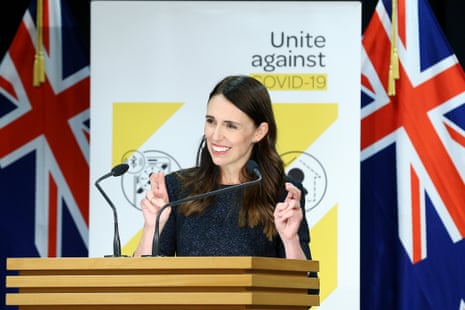
Comments (…)
Sign in or create your Guardian account to join the discussion